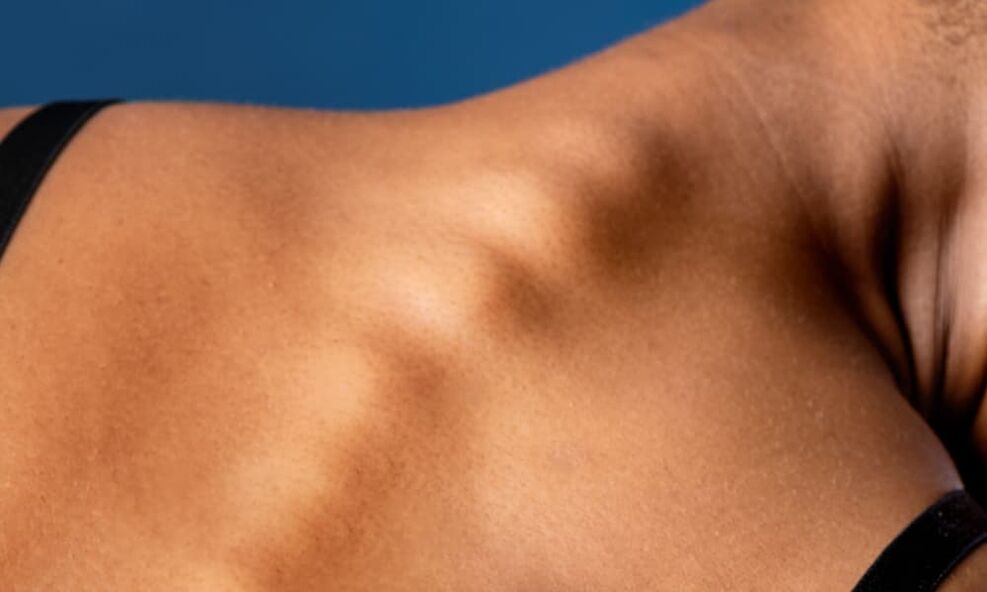
Osteoarthritis– is a degenerative - dystrophic disease, manifested by a decrease in the height of the internal intervertebral cartilage. Ultimately, this leads to disc wear and loss of functionality.
The disease is usually diagnosed in people aged 30-35 and affects about 40% of the population under 35-40 years of age and almost 90% of the elderly. However, if unfavorable factors are encountered, it may appear earlier.
Spinal degeneration is one of the main causes of back pain. Inadequate treatment can lead to nerve root damage, spinal cord damage, and disruption of internal organs. Therefore, it is very important to quickly seek medical help and take appropriate measures to prevent the development of the disease.
Causes of osteoarthritis
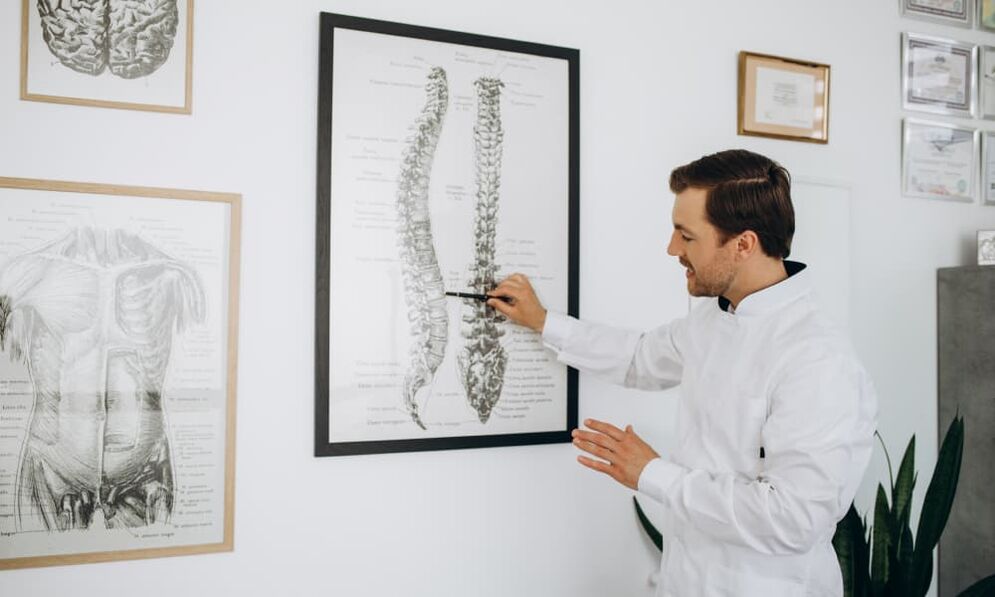
Osteonecrosis is a common disease that can occur in older people, but it can also occur in younger people who are accustomed to a sedentary lifestyle. This disease develops due to weakening of the back muscles, leading to disruption of blood flow and nutrition of spinal tissues and intervertebral discs. It can occur due to many reasons, including aging, injury, sudden stress, and improper work habits.
Although the causes of osteochondrosis are not fully understood, they are related to a variety of factors, including:
- genetic,
- defects in physical development,
- metabolic disease,
- unhealthy diet
- lack of vitamins and minerals,
- long-term drug use,
- overweight,
- increased load on the spine,
- sedentary lifestyle, for example, when working in the office,
- spinal cord injury,
- Infectious diseases and past stress.
In addition, defects of the nervous and musculoskeletal systems can also contribute to osteoarthritis. In general, the development of this disease is due to a combination of many factors, and its prevention includes proper nutrition, moderate physical activity, proper distribution of load on the spine as well as maintenance. maintain a healthy lifestyle in general.
Symptoms and signs of osteoarthritis
With the development of osteonecrosis, in the early stages, patients often experience the following problems:
- Pain in different parts of the body, such as the back, neck, or other areas;
- Difficulty moving and limited turning or bending;
- Constant tension and muscle spasms;
- Migraines and dizziness;
- Feeling of pain in the heart area;
- Hypotension, decreased muscle tone and strength;
- Numbness of limbs;
- Pain in arms and legs;
- Seeing spots before the eyes;
- Cools extremities;
- Capture painful feelings.
If osteochondrosis progresses, serious complications can occur, such as:
- Loss of consciousness;
- Reduced sensitivity of the limbs;
- Poor blood circulation in blood vessels;
- Nerve damage or inflammation;
- Narrowing and blockage of arteries.
You should pay attention to any changes in the condition of the body and seek help from a specialist if you suspect the development of osteonecrosis. Seeking help early can prevent serious complications and improve quality of life.
Risk factors
Osteonecrosis can occur as a result of trauma or heavy physical activity, and is especially common in athletes. It also manifests in the form of bone overgrowth, bone spurs, bulging discs and scoliosis. Congenital spinal deformities can also cause rapid disc wear. In addition, the following risk factors can lead to the development of osteonecrosis:
- Neuro-emotional exhaustion;
- Physical stress of the body;
- Work on vibrating platform;
- Genetic predisposition;
- The body lacks vitamins;
- Multiple pregnancies.
Understanding these risk factors can help you prevent the possibility of developing osteonecrosis. Managing your health through a healthy lifestyle and diet, as well as avoiding injury and overexertion, can reduce the likelihood of this problem occurring. If you suspect osteoarthritis, consult your doctor to quickly begin treatment and prevent possible complications.
Classification and stages of development of osteoarthritis
Classification of osteoarthritis
There are different forms of osteoarthritis, which can manifest as pain in different parts of the spine.
- migraine headache– this is pain in the lumbar region (lumbosacral).
- Sciatica body painSymptoms are back pain, spreading to the legs.
- Low back pain- This is low back pain, acute and severe pain in the lumbar region.
- Chest pain- This is chest pain.
Another form of osteoarthritis, cervical pain or cervical pain, causes pain in the neck and upper limbs.
Additionally, the types of osteoarthritis can vary depending on which part of the spine is affected. Cervical spondylosis is manifested by headaches and difficulty turning the head, cervical spondylosis causes pain in the thoracic spine, and lumbar spondylosis can manifest as difficulty bending forward and double pain. when you can "shoot" it. foot.
Stages of development of osteoarthritis
Osteonecrosis is one of the most common diseases of the spine. Its development went through many stages.
- I.In the early stages, the core of the disc loses moisture and becomes less elastic, leading to loss of height and tissue cracking. At this stage, pain is often barely noticeable, but discomfort may occur with physical activity or unusual positions.
- II.In the second stage of the development of cartilage degeneration, the intervertebral disc tissue begins to collapse and swell, leading to narrowing of the space between the vertebrae and compression of the spinal nerve roots. The fiber membrane is destroyed, leading to poor water retention in the disc core. When moving, you can hear characteristic clicking and crunching sounds in the spine. At this stage, point pain appears, intensifying with active movements.
- III.The third stage is characterized by wear and thinning of the cartilage between the discs. At this stage, symptoms of osteonecrosis appear clearly in the form of acute pain. To relieve pain quickly, you need to take painkillers for nerve pain.
- IV.In the final, fourth stage, the disc is destroyed so severely that the joints become inactive and the spaces between the vertebrae are overgrown with bone tissue. Severe dystrophy can cause acute pain because the growth damages nearby tissues and compresses nerves. There may be complete loss of mobility of the vertebral joints.
symptoms
Let's look at the various complications that can arise with osteoarthritis:
- Disc protrusion, occurs when the nucleus pulposus of the intervertebral disc protrudes beyond the annulus fibrosus. This can lead to pain and spinal dysfunction.
- Intervertebral hernia- This complication becomes more serious when the disc ring breaks and the disc nucleus spreads out. This can cause severe pain, decreased sensation and numbness.
- Inflammation of the nerve root- This is a condition in which nerve roots are compressed, accompanied by symptoms of severe pain. Radiculitis can lead to loss of sensation, numbness, and weakness in the lower extremities.
- Kyphosis of the spineis a spinal deformity manifested by a bulge in the chest area. This can lead to breathing problems, pain, and poor posture.
- Spinal cord stroke– this is the most serious complication of osteonecrosis, which can lead to loss of sensitivity, impaired motor function and even paralysis.
- Lower limb muscle atrophy– this is a condition in which muscle mass is reduced, accompanied by rapid fatigue and weakness in the legs.
- leg paralysis– this is the complete loss of the ability to perform voluntary movements of the lower limbs, which is a serious complication of osteonecrosis.
Methods of diagnosing osteoarthritis
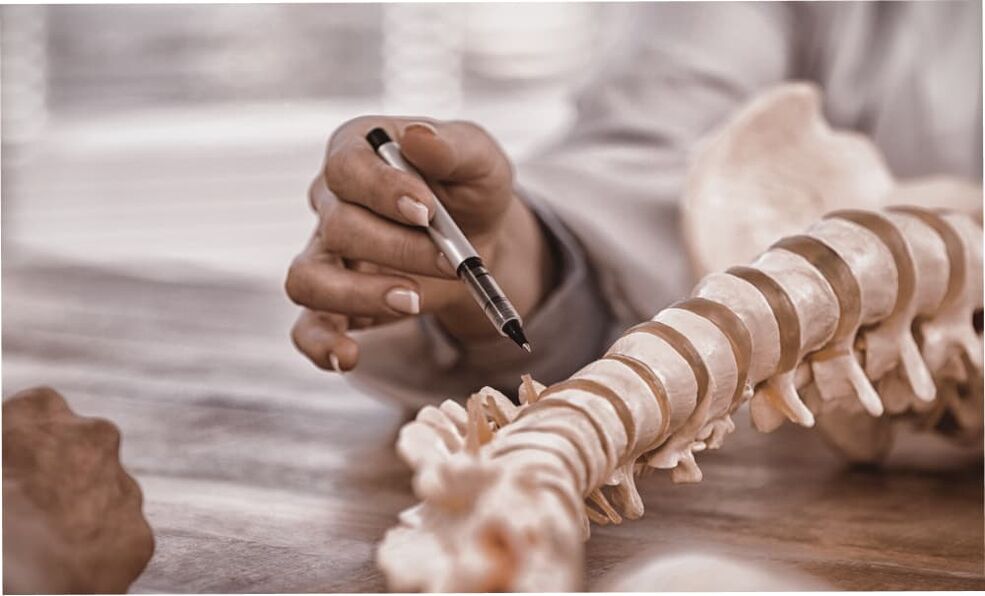
Osteonecrosis is a pathology characterized by degenerative processes in the structures of the spine. Based on clinical studies, we can learn more about how to treat this condition.
If osteoarthritis is suspected, your doctor will conduct a comprehensive diagnosis, including the following methods:
- Physical examination.The doctor examines the patient and evaluates the patient's general condition, posture and movements. Your doctor may also perform neurological testing to determine the presence or absence of sensory and motor problems.
- Check the hardware.For a more accurate diagnosis, various hardware testing methods are used, including X-rays, computed tomography (CT) and magnetic resonance imaging (MRI).
- Blood tests.A complete blood count can help identify early signs of osteonecrosis, such as increased erythrocyte sedimentation rate and low calcium levels. To confirm the diagnosis, biochemical tests may be prescribed to evaluate coagulation parameters, enzyme activity, zinc content, cobalt, iron and other components.
- X-ray.During an X-ray, each spine is examined and images are taken in direct, lateral, and bi-oblique views. If necessary, functional radiography may be prescribed, which allows you to evaluate the condition of the spine in various positions.
- Computed tomography (CT).CT is performed after X-rays and allows you to more accurately determine the condition of the intervertebral discs. To do this, images of one or two spinal segments will be taken.
- Magnetic resonance imaging (MRI).MRI is used in conjunction with CT or in cases where a more detailed study of the condition of blood vessels, nerve processes and intervertebral discs is required.
When to see a doctor
It is necessary to consult a doctor in case of persistent back pain, cramps and decreased sensitivity.
Treatment of osteoarthritis
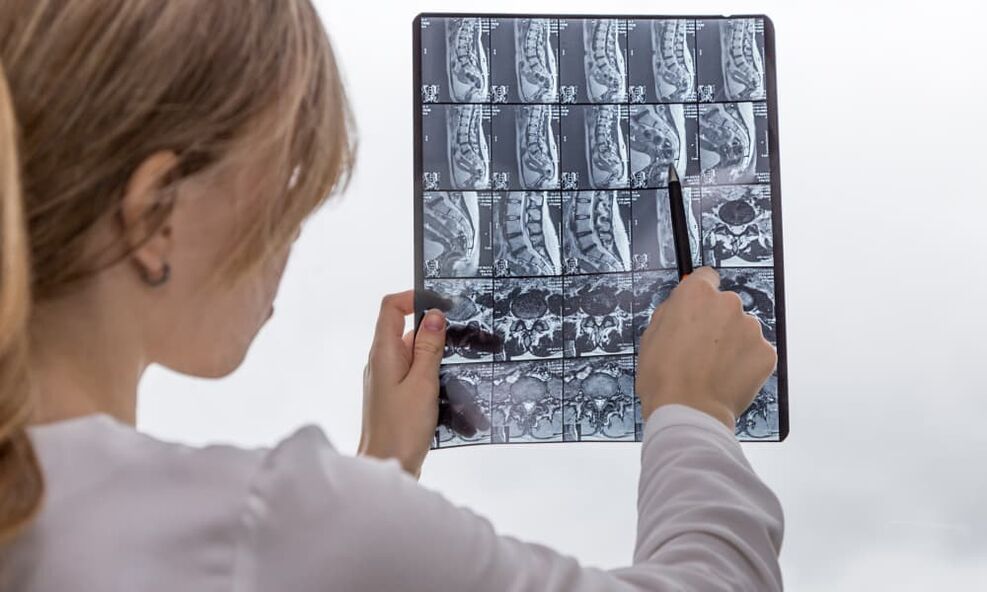
Osteonecrosis is a disease of the spine characterized by degenerative changes in the intervertebral discs. It can lead to back pain, neck pain, headaches, and other unpleasant symptoms. Treating osteoarthritis can be a long and laborious process, but modern methods can help reduce pain and improve quality of life. It can be conservative or surgical, depending on the progression and severity of symptoms. In most cases, strengthening of ligaments and muscles as well as the use of medication is recommended.
When treating osteoarthritis, it is important to take into account the individual characteristics of each patient. Some massage or manual therapy methods may be undesirable or even dangerous for a particular case. Therefore, it is important to conduct an individual consultation before starting treatment.
Osteoarthritis procedures and treatments include physical therapy, gymnastics (physical therapy), wearing orthopedic pillows or corsets, as well as muscle relaxants and nonsteroidal pain relievers. .
Exercise therapy
Leading countries with good medical qualifications prefer to use occupational therapy. These are classic physiotherapy, physiotherapy exercises in water, swimming, simulation training and computer hardware complexes. The style is chosen by the doctor and may vary depending on the individual characteristics of each patient. Swimming can also be beneficial, but proper technique is needed to avoid harming your health.
Treatment of osteoarthritis with manual therapy
Manual therapy can be used in the early stages. This method helps strengthen the musculature and eliminates blockage and nerve root compression. However, if the shape of the vertebra changes and bone spurs form, this treatment is not recommended.
Manual therapy, performed properly, can improve the configuration of the spine. Sometimes persistent functional blockages may be present, i. e. areas of stiffness in the spine and sacrum that cannot be removed by therapeutic exercises.
Modern manual therapy is different from what was used before. Most doctors no longer use the hard techniques associated with crunches, preferring softer techniques. They are based on knowledge of biomechanics, joint function and the laws of muscle contraction and relaxation. The risk of side effects with these methods is lower and the effectiveness remains unchanged.
Massage
Massage has many contraindications, so the neurologist must prescribe an individual course of treatment. It is important to choose a competent massage therapist that the doctor works with. Massage should be performed regularly, usually doctors prescribe at least 2-3 sessions per week for 1-3 months.
Perform medical massage properly for degenerative spine disease:
- Provides additional tension to the muscles and increases their tone;
- Dispels lactic acid buildup and relieves muscle spasms;
- Improves blood circulation in the affected area and neighboring tissues;
- Pain relief.
Only medical massage is suitable for treating osteoarthritis, while Thai massage is very dangerous. Most Thai massage therapists use harsh manual therapy techniques and do not pay attention to the patient's physical condition.
Physical therapy
Depending on the location and stage, patients may be prescribed the following types of physical therapy:
- Magnetic field therapyis the effect of a constant frequency magnetic field that stimulates a cell's response.
- Electrophoresis for osteoarthritis– this is the effect of an electric field on tissue, which speeds up blood circulation and activates regeneration processes.
- Laser therapyis a method of stimulating biological processes in nerve fibers and also has anti-inflammatory, wound-healing and pain-relieving effects.
- Shock wave therapyis a method of affecting diseased areas of the body with sound waves, helping to improve microcirculation and metabolism, reducing swelling and pain.
All of these methods can be prescribed by the doctor depending on the individual needs of the patient and the stage of the disease.
Kinesio recording
Kinesio tape is a safe method that is actively used in sports medicine and is popular in Korea.
Kinesio tape is a cotton pad with hot-melt adhesive that can be used to treat neck, chest, back, and joint problems. There are special types of therapeutic applications that can be used at home, but when bandaging yourself, you need to be careful because complications can occur.
When performing kinesiotaping, it is necessary to note the limitations: for women, these are pregnancy and menstruation. Some patients may have an allergic reaction to the patch.
Acupuncture
Acupuncture is a method in which doctors insert special needles into specific areas of the body. This leads to acceleration of blood circulation, lymph circulation and metabolic processes, improving the condition of the spine and the entire body. Acupuncture can be used to treat osteoarthritis in the early stages, as well as when treating severe pain and poor mobility of the vertebrae.
There is also a dry needling technique in which a drug-free needle is inserted into the muscle that is in spasm, usually the piriformis muscle. This method can reduce pain in the back and pelvic area. It is worth noting that acupuncture is effective even in chronic cases.
Hirudo therapy
Leechrotherapy is used to treat various diseases, including osteoarthritis. Hirudotherapy prevents blood clotting and clot formation, dilates blood vessels, eliminates inflammatory processes and has an analgesic effect. For osteoarthritis, leeches are used to improve blood supply to cells, thereby stimulating recovery of damaged discs.
Treatment medicine
Currently, there is a trend to reduce the use of drugs in the treatment of osteoarthritis. This is because some medications can have serious side effects and negatively affect a patient's health.
Pain from osteoarthritis often occurs due to small changes in the spine, and if the doctor chooses the right treatment without medication, the patient can avoid repeated pain. If you take the medication for a long time, structural changes in the spine may become more severe and the medication may no longer be effective. In addition, drug treatment may be contraindicated in some cases.
An alternative to drug treatment is kinesio patching. This is a method in which special elastic patches are applied to diseased areas of the body. Kinesio tape is safer and more effective than drug treatment and can be used as a pain reliever.
Acupressure
Acupressure is a method based on precise impact on pain points and reflex areas. It is used to relieve pain and restore the natural load to the spine. Acupressure is never used alone but is often used in conjunction with massage to achieve more pronounced effects.
Acupressure techniques can be used to treat osteoarthritis and other spinal diseases. Its use eliminates pain and restores the natural load on the spine. In addition, acupressure can be used to improve the general condition of the body and prevent disease.
Prevention and prognosis of osteoarthritis
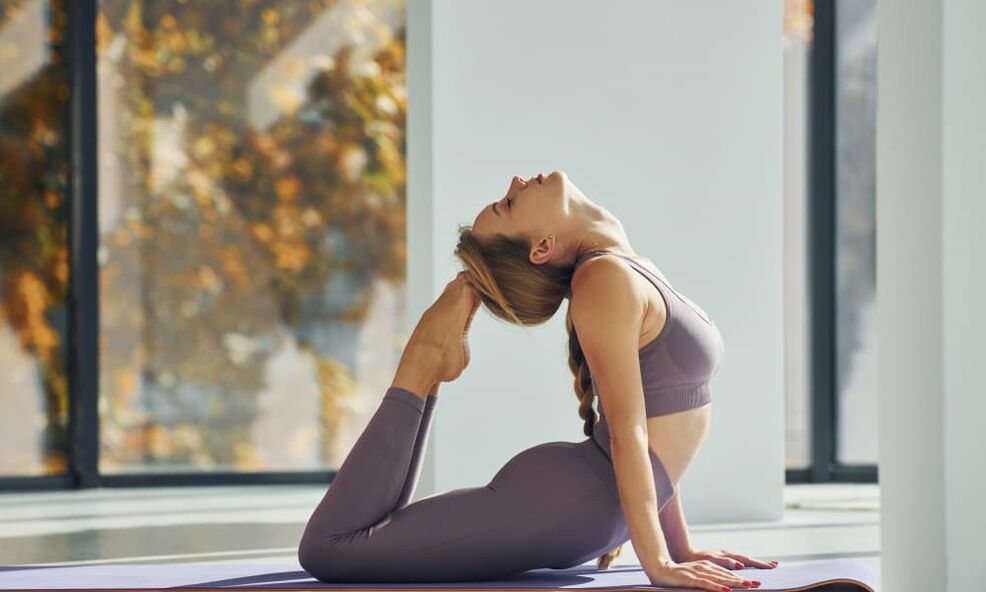
Prevention of osteoarthritis is an extremely important issue, as it is aimed at preventing factors that can contribute to the development of this disease. First of all, this applies to people with certain risks:
- Genetic predisposition to diseases of the spine;
- Chronic gastrointestinal problems can lead to malabsorption of nutrients;
- Diseases related to metabolic disorders;
- Severe infections during childhood, such as rickets;
- Spinal cord injury;
- Overweight.
However, prevention is also important for people with a sedentary lifestyle, with a lot of pressure on the spine, and for women who are planning to become pregnant. For prevention, you should exercise regularly, monitor your weight, avoid injuries and have a healthy diet rich in vitamins and minerals. You should also consult a doctor and have regular health checks to detect the disease in its early stages.
Diet for osteoarthritis
One of the important aspects of treating osteoarthritis is proper nutrition. The body must receive the necessary amount of substances to synthesize cartilage tissue, so it is recommended to follow a balanced diet.
It is important to eat fresh fruits and vegetables, foods rich in protein, as well as dishes containing mucopolysaccharides - such as fruit jelly, jelly or jelly fish. However, you should avoid fatty, fried and salty foods, and limit your intake of sugar and alcohol as they can contribute to inflammation.
Drink more water to ensure proper hydration and maintain the health of the intervertebral discs. It is also recommended to consult a doctor or nutritionist to develop an individual diet that takes into account the characteristics of the disease and the individual needs of the patient.
Exercises for osteoarthritis
Exercises to treat spondylosis are prescribed by the doctor if there is pain. The set of exercises is selected individually, taking into account the form, severity and stage of the disease. For example, in the early stages of cervical spondylosis, you should:
- perform head tilt;
- turn your head right and left;
- Use your chin to draw the numbers 0 to 9 in the air;
- Move your chin forward and backward in a horizontal plane.
























